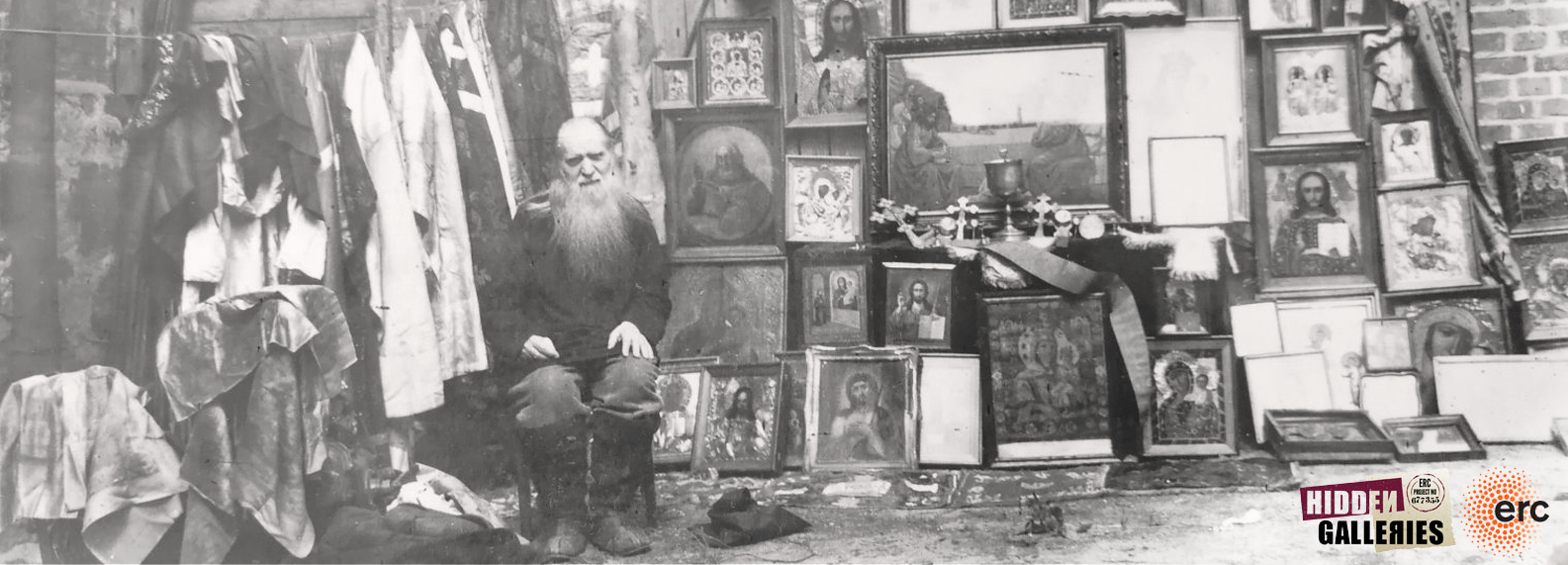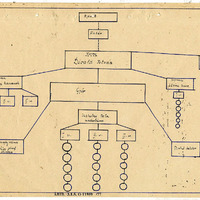Network scheme of Hungarian Catholic underground cells
Item
Title
Network scheme of Hungarian Catholic underground cells
Földalatti magyar katolikus csoportokról készült hálózati ábra
Description
This network scheme is from a file on a Hungarian Catholic underground movement. Hand drawn and sketchy, it is a less sophisticated version of its more elaborate and detailed – and sometimes almost artistically executed – Soviet and Romanian counterparts. The purpose of network schemes was to map the connections of groups or individuals; in this case it shows the people István Divald, a young Piarist monk recruited to the Catholic underground movement lead by György Bulányi. Amongst the recruits we find a canon, three parish priests and a catechism teacher from three settlements in north-western Hungary, Győr, Sopron and Csorna. According to the scheme, two of the recruits headed three subgroups, while one of them lead only one. Since the scheme comes without any notations, it is unclear what the little circles below some of the groups stand for, but most probably they indicate the number of members in each group. The scheme also shows that Divald communicated with the Budapest centre of the movement via “couriers” who, according to various reports in the file were mostly university students. We don’t know the exact date of the network scheme but it should have been drawn sometime in 1951 or early 1952.
István Divald joined the underground Catholic movement in 1949 or – according to some sources – 1950. After his monastery was closed in 1950 he worked as a chaplain in Kóny, a village near the county capital Győr, and this is where he started to organise the underground cells shown in the network scheme. According to reports in the file Divald regularly visited and lead the cells he helped organise, and was especially successful in engaging young people: he frequented pubs, played cards and bowls and organised the local volleyball team. Authorities deemed the whole movement extremely dangerous and alleged that it “did not only try to ideologically influence its members but prepared them for terrorist activity and diversive action.” Divald was dispelled from the diocese in 1951 and from 1952 – the year the movement’s leaders were arrested – had various non-ecclesiastical jobs. His relationship with the secret police took a turn sometime in 1954 when he was officially roped in as agent “Dusek”. From then on he regularly reported on the resurgent cells of various Catholic underground movements such as Catholic women’s groups and scouts groups with which he was also actively involved as an occasional lecturer. In the summer of 1956, before the planned arrest of the second generation of underground Catholic group leaders, Divald emigrated with the help of the secret police first to Austria and in 1957 to the USA. Between 1962 and 1965 he reprised his role as an active agent under the cover name “Broger”.
The network scheme is included in file ÁBTL 3.1.5 O-11959, which also contains summary reports, confessions under interrogation, reports on shadowing and informer’s reports.
István Divald joined the underground Catholic movement in 1949 or – according to some sources – 1950. After his monastery was closed in 1950 he worked as a chaplain in Kóny, a village near the county capital Győr, and this is where he started to organise the underground cells shown in the network scheme. According to reports in the file Divald regularly visited and lead the cells he helped organise, and was especially successful in engaging young people: he frequented pubs, played cards and bowls and organised the local volleyball team. Authorities deemed the whole movement extremely dangerous and alleged that it “did not only try to ideologically influence its members but prepared them for terrorist activity and diversive action.” Divald was dispelled from the diocese in 1951 and from 1952 – the year the movement’s leaders were arrested – had various non-ecclesiastical jobs. His relationship with the secret police took a turn sometime in 1954 when he was officially roped in as agent “Dusek”. From then on he regularly reported on the resurgent cells of various Catholic underground movements such as Catholic women’s groups and scouts groups with which he was also actively involved as an occasional lecturer. In the summer of 1956, before the planned arrest of the second generation of underground Catholic group leaders, Divald emigrated with the help of the secret police first to Austria and in 1957 to the USA. Between 1962 and 1965 he reprised his role as an active agent under the cover name “Broger”.
The network scheme is included in file ÁBTL 3.1.5 O-11959, which also contains summary reports, confessions under interrogation, reports on shadowing and informer’s reports.
For further readings on István Divald see:
Szende Ákos 2013 Akit az államvédelem szöktetett ki Nyugatra: Divald István (1923–1972) In Szende Ákos (ed): Piarista eszmék és sorsok a 20. századból: tanulmányok. Magyarország Piarista múltjából 6. Piarista Rend Magyar Tartománya: Budapest, 183–228.
Szende Ákos 2013 Akit az államvédelem szöktetett ki Nyugatra: Divald István (1923–1972) In Szende Ákos (ed): Piarista eszmék és sorsok a 20. századból: tanulmányok. Magyarország Piarista múltjából 6. Piarista Rend Magyar Tartománya: Budapest, 183–228.
For further entries on the Hungarian Catholic underground movement:
A képen látható hálózati ábra a Bulányi György által alapított földalatti katolikus mozgalommal foglalkozó egyik dossziéból származik. A titkosszolgálatok ilyen hálózati ábrákat használatk az egyes csoportok és egyének kapcsolathálójának feltérképezésére és ábrázolására: ezen, az aprólékos, szinte művészi gonddal kidolgozott szovjet és román hálózati ábrákhoz képest meglehetősen kezdetlegesnek tűnő, kézzel rajzolt magyar ábrán azok a személyek láthatók, akiket a fiatal piarista pap, Divald István szervezett be a mozgalomba. A Győrben, Sopronban és Csornán szolgáló beszervezettek között egy kanonokot, három plébánost és egy hittanoktatót találunk. Az ábra szerint kettejük alá három alcsoport is tartozott, míg egyikük csak egy csoportot vezetett. Mivel az ábrához a dossziéban semmilyen magyarázat nem tartozik, nem tudjuk, hogy az egyes alcsoportok alá rajzolt körök mit jelentenek, de nagy valószínűséggel a csoporttagok számát jelölhetik. Az ábráról az is világos, hogy Divald a mozgalom budapesti központjával „futárokon” keresztül tartotta a kapcsolatot, akik a dossziéban olvasható több jelentés szerint is jobbára egyetemisták voltak. Az ábra nem datált, de valószínűleg 1951-ben vagy 1952 elején keletkezhetett.
Divald 1949-ben, egyes források szerint 1950-ben csatlakozott a mozgalomhoz. Rendházának 1950-ben történt bezárása után a Győr melletti Kónyba került káplánnak, és itt kezdte meg az ábrán látható mozgalmi sejtek megszervezését. A dossziéban olvasható jelentések szerint rendszeresen „lelátogatta” és ellenőrizte e csoportok vezetőit, és kifejezetten tehetségesnek mutatkozott a fiatalok megszólításában: „[E]nnek érdekében meglátogatta a korcsmát, ott kuglizott, kártyázott, továbbá megszervezett egy röplabdacsapatot.” A hatóságok a mozgalmat rendkívül veszélyesnek tartották, amely „nem csak ideológiailag befolyásolja a csoport tagjait, hanem terror és diverzió-akciókra készíti elő a csoport egyes tagjait.” Divald 1951-ben kényszerült az egyházmegye elhagyására, és 1952-től különböző világi munkákból tartotta fenn magát. Kapcsolata az állambiztonsággal 1954-ben vett éles fordulatot, amikor is „Dusek” néven beszervezték; ettől kezdve rendszeresen jelentett különböző földalatti katolikus sejtekről, például katolikus női- és cserkész csoportokról, akiknél alkalmi előadóként is megfordult. 1956 nyarán, a földalatti katolikus mozgalomvezetők második generációjának tervezett letartóztatása előtt Divald a titkoszolgálatok segítségével először Ausztriába, majd 1957-ben az Egyesült Államokba emigrált. Innen 1962 és 1965 között „Broger” fedőnéven jelentett.
A hálózati ábra az ÁBTL 3.1.5 O-11959 dossziéban található, amely főleg összefoglaló jelentéseket, kihallgatási jegyzőkönyveket, a célszemélyek követéséről szóló jelentéseket és ügynöki jelentéseket tartalmaz.
Divald 1949-ben, egyes források szerint 1950-ben csatlakozott a mozgalomhoz. Rendházának 1950-ben történt bezárása után a Győr melletti Kónyba került káplánnak, és itt kezdte meg az ábrán látható mozgalmi sejtek megszervezését. A dossziéban olvasható jelentések szerint rendszeresen „lelátogatta” és ellenőrizte e csoportok vezetőit, és kifejezetten tehetségesnek mutatkozott a fiatalok megszólításában: „[E]nnek érdekében meglátogatta a korcsmát, ott kuglizott, kártyázott, továbbá megszervezett egy röplabdacsapatot.” A hatóságok a mozgalmat rendkívül veszélyesnek tartották, amely „nem csak ideológiailag befolyásolja a csoport tagjait, hanem terror és diverzió-akciókra készíti elő a csoport egyes tagjait.” Divald 1951-ben kényszerült az egyházmegye elhagyására, és 1952-től különböző világi munkákból tartotta fenn magát. Kapcsolata az állambiztonsággal 1954-ben vett éles fordulatot, amikor is „Dusek” néven beszervezték; ettől kezdve rendszeresen jelentett különböző földalatti katolikus sejtekről, például katolikus női- és cserkész csoportokról, akiknél alkalmi előadóként is megfordult. 1956 nyarán, a földalatti katolikus mozgalomvezetők második generációjának tervezett letartóztatása előtt Divald a titkoszolgálatok segítségével először Ausztriába, majd 1957-ben az Egyesült Államokba emigrált. Innen 1962 és 1965 között „Broger” fedőnéven jelentett.
A hálózati ábra az ÁBTL 3.1.5 O-11959 dossziéban található, amely főleg összefoglaló jelentéseket, kihallgatási jegyzőkönyveket, a célszemélyek követéséről szóló jelentéseket és ügynöki jelentéseket tartalmaz.
Olvasmányok:
Szende Ákos 2013 Akit az államvédelem szöktetett ki Nyugatra: Divald István (1923–1972) In Szende Ákos (ed): Piarista eszmék és sorsok a 20. századból: tanulmányok. Magyarország Piarista múltjából 6. Piarista Rend Magyar Tartománya: Budapest, 183–228.
Szende Ákos 2013 Akit az államvédelem szöktetett ki Nyugatra: Divald István (1923–1972) In Szende Ákos (ed): Piarista eszmék és sorsok a 20. századból: tanulmányok. Magyarország Piarista múltjából 6. Piarista Rend Magyar Tartománya: Budapest, 183–228.
Kapcsolódó bejegyzések:
Subject
Communism and Christianity
Communism and religion
Surveillance
Religion and state--Europe
Communism--Hungary
Hungary. Államvédelmi Hatóság
Creator
Agnes Hesz
Source
Állambiztonsági Szolgálatok Történeti Levéltára
ÁBTL 3.1.5 O-11959
ÁBTL 3.1.5 O-11959
Publisher
This project has received funding from the European Research Council (ERC) under the European Union’s Horizon 2020 research and innovation programme No. 677355
Date
ca. 1951–1952
Rights
copyright for these images belongs to ÁBTL
Format
image/tif
Language
hu
Type
Image
Identifier
ÁBTL 3.1.5 O-11959
Coverage
20th century,
Hungary
Hungary
Bibliographic Citation
Agnes Hesz, "Network scheme of Hungarian Catholic underground cells,"
Date Created
2020

